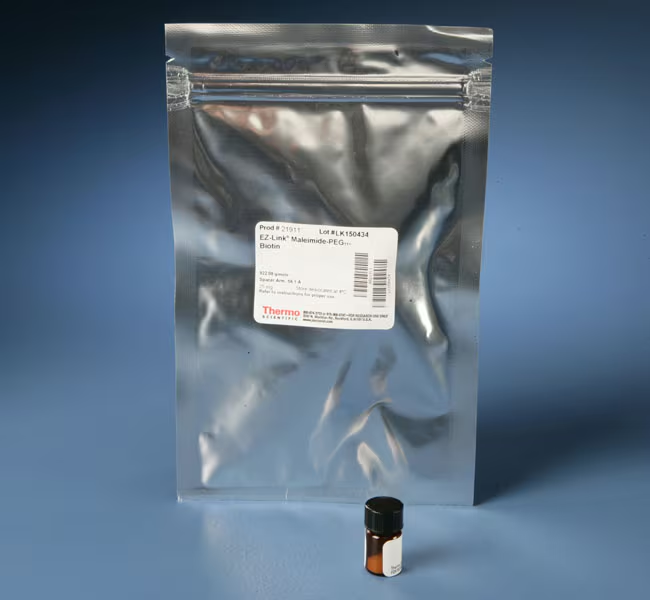
Thermo Scientific EZ-Link Maleimide-PEG11-Biotin is a long, maleimide-activated, sulfhydryl-reactive biotinylation reagent that includes an 11-unit polyethylene glycol spacer arm for increased water-solubility and reach.
Features of EZ-Link Maleimide-PEG11-Biotin:
• Protein labeling—biotinylate antibodies or other proteins for use in protein methods
• Thiol-reactive—reacts with sulfhydryls (-SH), such as the side-chain of cysteine (C)
• Maleimide-activated—perform reactions at pH 6.5 to 7.5 in buffers such as PBS
• Pegylated – spacer arm contains a hydrophilic, 11-unit, polyethylene glycol (PEG) group
• Enhances solubility – pegylation imparts water solubility to the biotinylated molecule, helping to prevent aggregation of biotinylated antibodies stored in solution
• Irreversible—forms permanent thioether bonds; spacer arm cannot be cleaved
• Solubility—can be dissolved directly in aqueous buffers for labeling reactions
• Long—spacer arm (total length added to target) is 59.1 angstroms
Maleimide-PEG11-Biotin enables simple and efficient biotinylation of antibodies, cysteine-containing peptides and other thiol-containing molecules. The maleimide group reacts specifically and efficiently with reduced thiols (sulfhydryl groups,—SH) at pH 6.5 to 7.5 to form stable thioether bonds. The hydrophilic, 11-unit polyethylene glycol (PEG) spacer arm imparts water solubility that is transferred to the biotinylated molecule, thus reducing aggregation of labeled proteins stored in solution. The PEG segment adds length and flexibility to the spacer arm, minimizing steric hindrance involved with binding to avidin molecules.
We manufacture biotin reagents to ensure the highest possible overall product integrity, consistency and performance for the intended research applications.
Biotinylation reagents differ in reactivity, length, solubility, cell permeability and cleavability. Three types of sulfhydryl-reactive compounds are available: maleimido, iodoacetyl and pyridyldithiol. Maleimide reagents specifically react with sulfhydryl groups (-SH) in near-neutral buffers to form permanent thioether bonds.
In proteins, sulfhydryls exist where there are cysteine (C) residues. Cystine disulfide bonds must be reduced to make sulfhydryl groups available for labeling. Hinge-region disulfide bridges of antibodies can be selectively reduced to make functional half-antibodies that can be labeled.
| Code | Description |
|---|---|
| 21911 | Catalog Number: 21911 |

